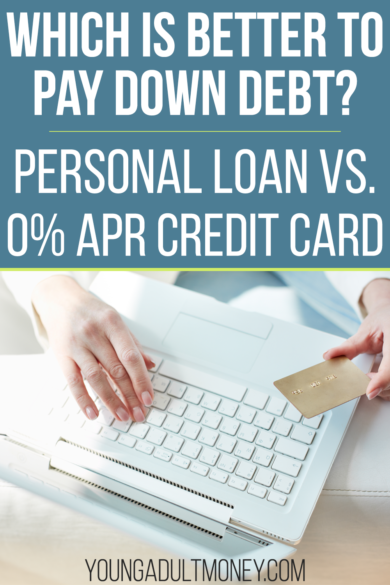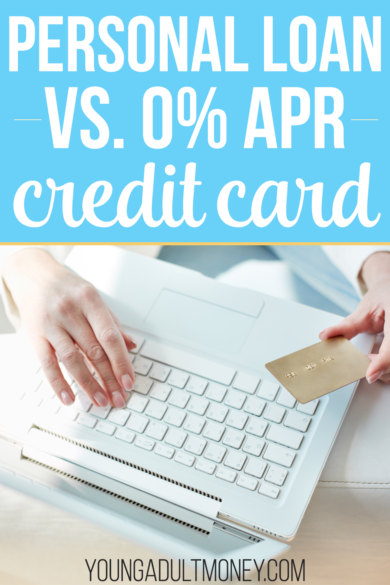 Debt, especially consumer debt, can be one of the hardest things to climb out of. And if you find yourself in debt, you may be considering resources to help you pay off your debt faster.
Debt, especially consumer debt, can be one of the hardest things to climb out of. And if you find yourself in debt, you may be considering resources to help you pay off your debt faster.
Both personal loans and 0% APR credit cards can be used to aid in debt repayment. But how do they work? And how do you know if one method is right for you? Here’s everything you need to know about personal loans versus 0% APR credit cards.
What is a Personal Loan?
A personal loan is just that – a loan you can take out for various personal reasons. While personal loans can be used for a variety of reasons, they are often used to pay off high-interest debt.
It works by this: once you are approved for a personal loan, you can use that amount you received to pay off your original debt. Then, instead of making monthly payments to your original lender, you now make payments to your personal loan provider. You pay a regular, fixed amount each month until your personal loan is paid off.
Personal loans are installment loans, which means you receive the loan amount all at once and repay it according to a fixed repayment plan.
Pros of Personal Loans
At first, the idea of a personal loan may seem redundant. Why pay off debt with another form of debt? Well, there are a few reasons.
First, the interest rate of a personal loan is often lower than other debt interest rates. Say, for instance, you have $5,000 in credit card debt. You are paying the average credit card interest rate, which is around 18.61%. Each month, a large portion of your payment goes towards interest. It may not even feel like you are making much progress in paying off your credit card debt.
Now, say you took out a personal loan for $5,000 at the average rate of 9.41%, according to Experian. While you are still paying a relatively high interest rate, it is much lower than the 18.61% interest rate of your original credit card debt.
Another advantage of personal loans is the ability to consolidate. If you have multiple debts, such as two credit cards you’re paying off, you can consolidate them by using a personal loan. Since you repay personal loans at a fixed rate every month, you may find it easier to do that than to pay multiple lenders.
Cons of Personal Loans
One drawback of personal loans is the interest rate. While the average interest rate on a personal loan may beat the typical credit card interest rate, it all depends on your credit score. If you have fair or ad credit, you will likely find you receive quotes for much higher rates.
Secondly, while the fixed monthly payments can be nice in some circumstances, they are also difficult to adjust. So if you find yourself in a period of financial hardship, you may not be able to have much flexibility with your lender.
What is a 0% APR Credit Card?
A 0% APR credit card is one with a 0% interest rate for a set period of time. Many credit card companies offer 0% interest for a period of time (usually around one year) as a promotion to get new customers in the door.
Like any other credit card, a 0% APR card is considered a revolving form of credit. Unlike a personal loan where you are given a one-time lump sum, with a credit card, you can spend up to your limit, pay it off, and continue spending.
To aid in debt repayment, you can transfer your debt balance to a 0% APR credit card. Now, instead of paying off the original lender, you are paying off your credit card. Keep in mind, if you don’t pay off the credit card by the time the introductory period is up, the interest rate can skyrocket back up.
Pros of 0% APR Credit Cards
If used correctly, you can pay off debt without paying any interest, hastening your debt repayment progress.
Let’s go back to an example where you have $5,000 in credit card debt. You were approved for a credit card with a 0% APR for one year. You transfer the $5,000 balance to your new credit card. Ideally, you then pay off the $5,000 of debt within the one year period so you aren’t paying anything in interest.
Cons of 0% APR Credit Cards
Using a 0% APR credit card to pay off debt requires dedication and commitment on your part.
There is no lender holding you to a set repayment schedule, so it can be easy to not pay your credit card, and then end up right back where you were. Or worse, you could rack up even more credit card debt after the introductory period is over.
Other cons include the annual fees sometimes associated with credit cards And if you have a fair to poor credit score, it may be difficult to get approved for a 0% APR credit card.
Many credit cards charge a balance transfer fee, which typically ranges between 3% to 5% of the transfer balance. Do your research in advance to see if you will be charged a balance transfer fee.
Which Option Is Right for You?
Both personal loans and 0% APR credit cards can be good options, but it really depends on your circumstances. If you have a high debt balance and don’t think you could pay it off in the promotional period, then you may want to consider a personal loan instead. But if you’re confident you can pay off your debt in the intro period, then doing a balance transfer to a 0% APR credit card can save you a ton of money in interest. Either way, both can be used as tools to help you pay off debt even faster.
Click the options below to get free personal loan rate quotes on Credible (remember – getting a rate quote does not impact your credit) or browse 0% APR balance transfer credit cards.


